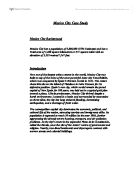Case Study: Telford and Wrekin, Shropshire
“It is a county of wide-ranging appeal both for residents and the many visitors who come each year, with outstanding natural beauty and great historic interest as well as modern developments.”
However, there are an increasing number of people moving to Shropshire for a permanent residency. Shropshire is England's largest inland county, covering an area of 1,347 square miles. To the west it, borders Wales and to the south, Herefordshire. In the north is Cheshire and to the east, Staffordshire. With a population of less than half a million, it is one of England's most sparsely populated counties and agriculture is an important part of the local economy. Some two-thirds of the population live in Shrewsbury, Telford or one of the ten main market towns, while the county's 600 villages and many scattered hamlets are home to the rest. Much of the population growth in the Borough occurred because of net in migration. In the 12 months preceding the Census.







